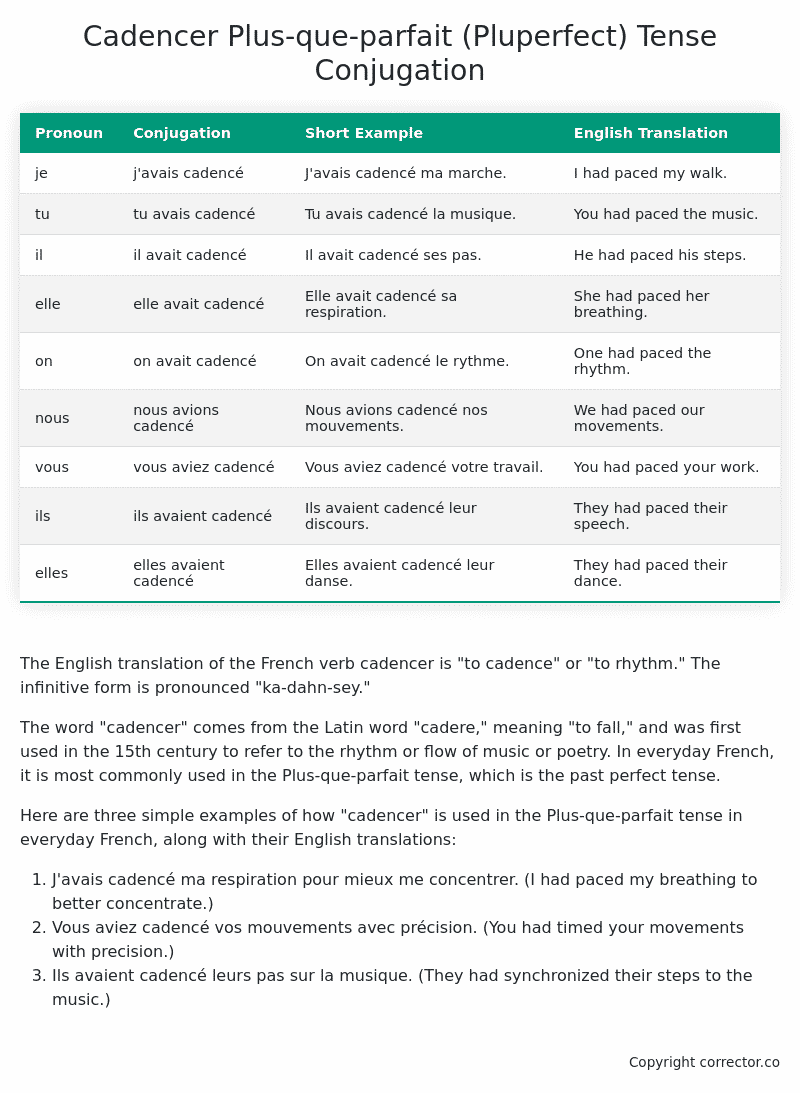Plus-que-parfait (Pluperfect) Tense Conjugation of the French Verb cadencer
Introduction to the verb cadencer
The English translation of the French verb cadencer is “to cadence” or “to rhythm.” The infinitive form is pronounced “ka-dahn-sey.”
The word “cadencer” comes from the Latin word “cadere,” meaning “to fall,” and was first used in the 15th century to refer to the rhythm or flow of music or poetry. In everyday French, it is most commonly used in the Plus-que-parfait tense, which is the past perfect tense.
Here are three simple examples of how “cadencer” is used in the Plus-que-parfait tense in everyday French, along with their English translations:
- J’avais cadencé ma respiration pour mieux me concentrer. (I had paced my breathing to better concentrate.)
- Vous aviez cadencé vos mouvements avec précision. (You had timed your movements with precision.)
- Ils avaient cadencé leurs pas sur la musique. (They had synchronized their steps to the music.)
Table of the Plus-que-parfait (Pluperfect) Tense Conjugation of cadencer
| Pronoun | Conjugation | Short Example | English Translation |
|---|---|---|---|
| je | j’avais cadencé | J’avais cadencé ma marche. | I had paced my walk. |
| tu | tu avais cadencé | Tu avais cadencé la musique. | You had paced the music. |
| il | il avait cadencé | Il avait cadencé ses pas. | He had paced his steps. |
| elle | elle avait cadencé | Elle avait cadencé sa respiration. | She had paced her breathing. |
| on | on avait cadencé | On avait cadencé le rythme. | One had paced the rhythm. |
| nous | nous avions cadencé | Nous avions cadencé nos mouvements. | We had paced our movements. |
| vous | vous aviez cadencé | Vous aviez cadencé votre travail. | You had paced your work. |
| ils | ils avaient cadencé | Ils avaient cadencé leur discours. | They had paced their speech. |
| elles | elles avaient cadencé | Elles avaient cadencé leur danse. | They had paced their dance. |
Other Conjugations for Cadencer.
Le Present (Present Tense) Conjugation of the French Verb cadencer
Imparfait (Imperfect) Tense Conjugation of the French Verb cadencer
Passé Simple (Simple Past) Tense Conjugation of the French Verb cadencer
Passé Composé (Present Perfect) Tense Conjugation of the French Verb cadencer
Futur Simple (Simple Future) Tense Conjugation of the French Verb cadencer
Futur Proche (Near Future) Tense Conjugation of the French Verb cadencer
Plus-que-parfait (Pluperfect) Tense Conjugation of the French Verb cadencer (this article)
Passé Antérieur (Past Anterior) Tense Conjugation of the French Verb cadencer
Futur Antérieur (Future Anterior) Tense Conjugation of the French Verb cadencer
Subjonctif Présent (Subjunctive Present) Tense Conjugation of the French Verb cadencer
Subjonctif Passé (Subjunctive Past) Tense Conjugation of the French Verb cadencer
Subjonctif Imparfait (Subjunctive Imperfect) Tense Conjugation of the French Verb cadencer
Subjonctif Plus-que-parfait (Subjunctive Pluperfect) Tense Conjugation of the French Verb cadencer
Conditionnel Présent (Conditional Present) Tense Conjugation of the French Verb cadencer
Conditionnel Passé (Conditional Past) Tense Conjugation of the French Verb cadencer
L’impératif Présent (Imperative Present) Tense Conjugation of the French Verb cadencer
L’infinitif Présent (Infinitive Present) Tense Conjugation of the French Verb cadencer
Struggling with French verbs or the language in general? Why not use our free French Grammar Checker – no registration required!
Get a FREE Download Study Sheet of this Conjugation 🔥
Simply right click the image below, click “save image” and get your free reference for the cadencer Plus-que-parfait tense conjugation!

Cadencer – About the French Plus-que-parfait (Pluperfect) Tense
Tense Formation
Common everyday usage patterns
Sequencing of past events
Background information
Hypothetical or reported speech
Interactions with other tenses
Summary
I hope you enjoyed this article on the verb cadencer. Still in a learning mood? Check out another TOTALLY random French verb conjugation!


